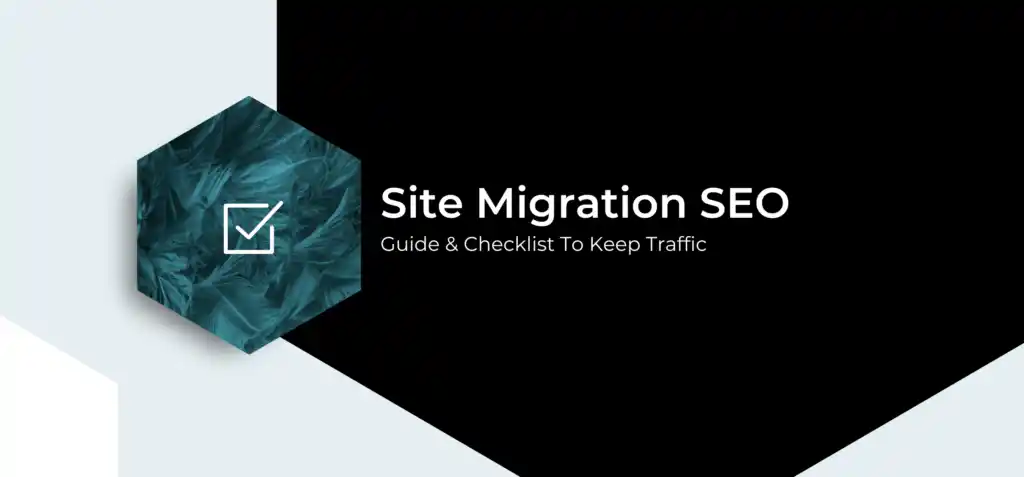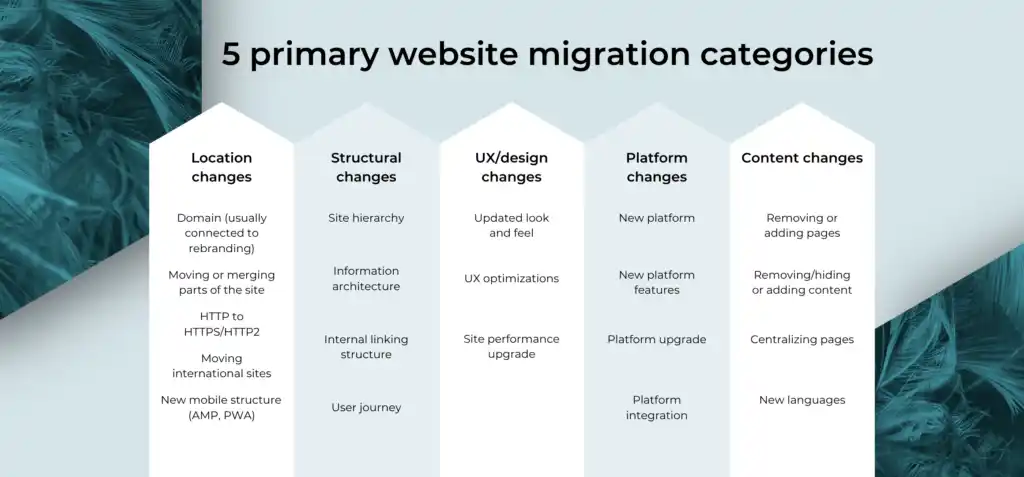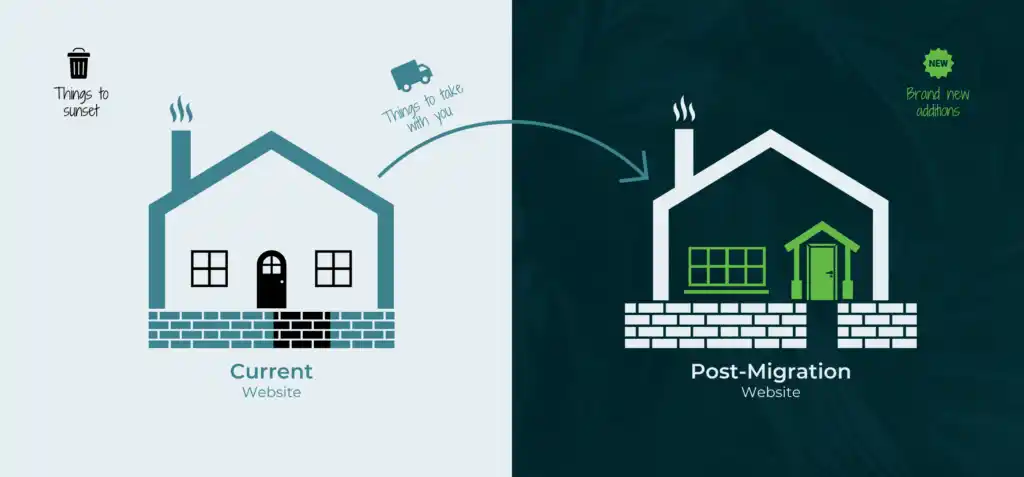
SEO site migration is probably not the first thing that comes to mind when you think about digital marketing, but in today’s landscape, it should be somewhere in your top 3.
Domain authority is more important than ever, which is why any migration (see below for the LONG list of items that qualify as a migration!) is inextricably linked with your overall marketing performance goals.
In this blog post, you’ll find a detailed SEO migration checklist and an informative guide to help you achieve a successful migration that improves (worst case scenario, maintains) your search engine rankings. Stay tuned for:
- Why your definition of a migration is probably wrong
- The 5 migration types
- How does migration affect SEO?
- 3 website migration mistakes to avoid
- The only SEO website migration checklist you need.
What is a website migration?
Website migration refers to the process of moving a website or subdomain from one hosting platform, domain, or infrastructure to another.
It requires careful planning, technical implementation, and thorough testing to ensure a smooth transition without losing data, functionality, or negatively impacting search engine visibility.
A brand might choose to engage in a website migration for a number of reasons, including:
- Rebranding
- Redesign
- New hosting provider
- Platform upgrade
- Domain name change.
Many things qualify as a migration: 5 migration types
A major miss in the marketplace is that most brand leaders view “site migration” too narrowly and don’t realize that a large array of activities qualify as a migration, which will always require SEO migration services.
There are 5 primary website migration categories:

ANY adjustment (visual, contextual, structural) constitutes a migration, which requires a re-coordination of backend elements to ensure that search engines understand the changes.
^^ That’s a vital detail, so let’s reiterate to be triple-clear here…
If your team has been discussing a possible change to your site and you figure that, surely, such a minor adjustment wouldn’t be described as a migration…
Any one of the following would qualify as a website migration, which in turn requires SEO migration support:
- Adding to the mega menu
- Shifting from a regular menu to a mega menu
- Any design changes (Really, ANYTHING.)
- Updating or rewriting existing content
- Reorienting the location or sequence of content (Yep, even adding drop downs.)
- Enhancing UI elements like buttons, forms, surveys, calculators, quizzes, etc.
- Optimizing site design for faster site speed or compliance with accessibility standards.
Altering any aspect of your site structure or visual or content components = migration.
And omitting SEO from a website migration risks significant domain authority losses that, in many scenarios, can take years and multiple 6-figures to recover from.
Here’s our simplest website migration analogy:
Imagine you’ve bought a new house. Ooh, all that natural light and clean lines. Stunning.
But you wouldn’t just haul across town and plop down in the new house with only the clothes on your back, right?
You’d start by moving all your cherished belongings out of the old house. You’d likely donate or trash some items, and you’d probably buy a few new things. And then you’d take your time to place all these objects in the new house in the right spot.

Your website is your brand’s “house” and the house-moving process needs SEO migration support that will protect your investment by:
- Connecting use cases
- Ensuring flow and functionality
- Putting the right things in the right spots (aka: adhering to search engine expectations in order to preserve and improve search rankings).
Migration is NOT simply a question of the technical or cost improvements of switching to a new domain host or platform. Any movement on your website needs Technical SEO expertise.
How exactly does migration affect SEO?
MASSIVELY, is the short answer.
Here are the primary SEO factors to pay close attention to throughout the website migration process, so you can minimize any negative impacts on your search rankings and traffic.
1. URL changes
If the URLs of your webpages change during the migration, the resulting broken links can lead to a loss of search engine visibility. Properly implementing 301 redirects from the old URL structure to the new one is crucial to preserve SEO value.
2. Content and keywords
Adjusting your website’s content or structure can affect keyword targeting. In addition to the significant backend work that happens during a migration, SEO experts also need to maintain (ideally, improve) keyword optimization in front-facing page titles, headings, and meta descriptions so that search engines continue to understand the relevance of your content.
3. Site structure
Changes to your website’s structure can restrict search engine bots’ ability to navigate and index your pages. The new site structure needs to be logical, well-organized, and adhere to all SEO best practices so that search engines can easily crawl your website (aka: understand it).
4. Page speed and performance
Website migration can sometimes lead to changes in server configurations or hosting providers, which can affect page load speed and overall performance. Optimizing your website for speed and ensuring it loads quickly on all devices is essential for a positive user experience and to remain “Google friendly”, which will impact both organic and paid traffic.
5. Mobile responsiveness
Mobile devices account for at least 55% of global internet usage, making it crucial that your migrated website is mobile-friendly and responsive. Search engines prioritize mobile-friendly websites in their rankings, so optimizing for mobile is a must.
6. Analytics and tracking
During migration, it’s essential to update your Google Analytics tracking codes to ensure accurate data collection and analysis. As long as GA tracking is in place, your Google Search console is verified so no additional tracking is required. In addition to maintaining your ability to accurately measure ongoing marketing activities, GA allows you to monitor and evaluate the impact of the migration itself, including key metrics like traffic, conversions, and more.
7. Search engine indexing
After migration, it’s important to submit an updated XML sitemap to search engines and monitor the indexing process. This provides search engines with a handy roadmap that helps them discover and index new pages efficiently.
8. Monitoring and adjustments
Migration work has several phases (more on that below). The most overlooked phase is post-migration. It’s important to monitor keyword rankings, traffic levels, and other SEO metrics to identify any issues or opportunities for improvement.
Website Migration Mistake #1: Broad alignment but no one to own the details
Korean designer, Teo Yang, likes to say, “Great design is in the details.”
Swap “design” for “website migration” and you’ve got the north star of SEO.
Picking a new domain or platform structure is only one piece of the puzzle. From there, the granular components of the migration are what will make or break your performance goals.
Metadata, content data, header tags (H1s, H2s, H3s), URLs and their 301 redirects, 404 management, your XML sitemap, and on and on.
This requires a methodical and highly structured approach, in addition to deep knowledge of search engine benchmarks and SEO best practices, to ensure that every iota is optimized to the highest possible degree.
Missing one detail or two can crush performance for your most trafficked page or the entire site. SEO is sensitive.
Website Migration Mistake #2: Missing the opportunity to optimize the pre-migration site.
Once a migration has been approved, there’s often a tendency to ignore the current site.
You’re about to move into a shiny, new house, so might as well leave the old one alone and reserve all your resources and time for sprucing up the new digs, right?
No, not right.
Implementing a data-driven keyword optimization strategy on your current site BEFORE you dive into launching a subdomain or redesign or refreshing your site architecture, opens up several performance advantages, like:
- Preserving any SEO value you’ve already built and maintaining search engine rankings
- Ensuring a smoother transition because you’re carrying over optimized content, which minimizes any potential impact on organic search visibility
- Improving the relevance of your content before substantive technical changes take effect, and delivering an enhanced user experience that attracts your intended audience.
Website Migration Mistake #3: Relying on developers (we love them!) for SEO
We work with some phenomenally talented developers. Big respect for their expertise.
And it’s a mistake to assume that your development team has the full knowledge base and skill set needed to effectively manage an SEO migration.
Developers are code experts – not SEO experts.
SEO subject matter experts should never tell a developer how to develop a site, but they should absolutely be the designated “SEO Site Migration Guide” telling the developer what highly specific code sequences need to be embedded in the new site to ensure that algorithms can successfully crawl the data.
The Apiary Website Migration SEO Checklist
*Note: The following SEO site migration checklist includes our general guidelines, but the most performance-friendly migrations are customized based on your specific migration requirements. Make sure to adapt this checklist accordingly.

Stage 1: Planning
- Define clear goals and objectives.
- Perform a comprehensive website crawl (Screaming Frog is a tool we like) to identify existing issues and optimization opportunities.
- Map out the current website structure, URLs, and content inventory.
- Create a backup of your current website to ensure data preservation.
- Build a testing environment so that you can thoroughly evaluate and test the site migration on a separate server, instead of risking significant setbacks to the live site.
Stage 2: SEO Considerations
- Conduct keyword research to inform content optimizations.
- Identify high-performing landing pages to prioritize in the migration.
- Set up proper redirects (301 redirects) from old URLs to the corresponding new URLs.
- Update internal links to reflect the new website structure.
- Submit XML sitemaps of the new website to search engines for efficient indexing.
Stage 3: Content Migration
- Review and update existing content for relevance, accuracy, and SEO improvements.
- Migrate content to the new website, ensuring proper formatting and structure.
- Implement 301 redirects for any changed or removed pages to maintain SEO value.
- Optimize meta titles, descriptions, and headings for targeted keywords and improved search visibility.
- Test and validate all migrated content to ensure proper display and functionality.
Stage 4: Technical Considerations
- Ensure proper hosting setup and server configuration for the new website.
- Test website functionality and performance across different browsers and devices.
- Check and update robots.txt file.
- Implement canonical tags to avoid duplicate content issues.
- Monitor website analytics and set up tracking to measure post-migration performance.
Stage 5: Post-Migration Analysis
- Monitor website traffic, rankings, and user behavior.
- Scan for issues like broken links, missing content, or a drop in indexed page count.
- Confirm the accuracy of all canonical tags.
- Schedule regular tech audits to identify issues that may not present immediately.
- Continuously optimize the website based on performance data and user feedback.
TL;DR on SEO site migrations
- Optimal digital marketing performance is inextricably linked with website SEO health.
- Website migration is the process of moving a website or subdomain from one hosting platform, domain, or infrastructure to another.
- “Infrastructure” in the bullet above includes myriad activities, and many brands are making website changes without realizing they’re engaging in a migration.
- Website migrations without SEO migration expertise lead to reductions in organic visitor traffic, paid campaign traffic, and overall domain authority.
- The 5 migration categories involve changes in site location, structure, UX/design, content, and/or platform.
- Migration Mistake #1: Relying on developers for SEO expertise. Please don’t!
- Migration Mistake #2: Beginning a migration without the subject matter expertise needed to address the highly technical SEO context of any migration.
- Migration Mistake #3: Not optimizing the pre-migration site.

